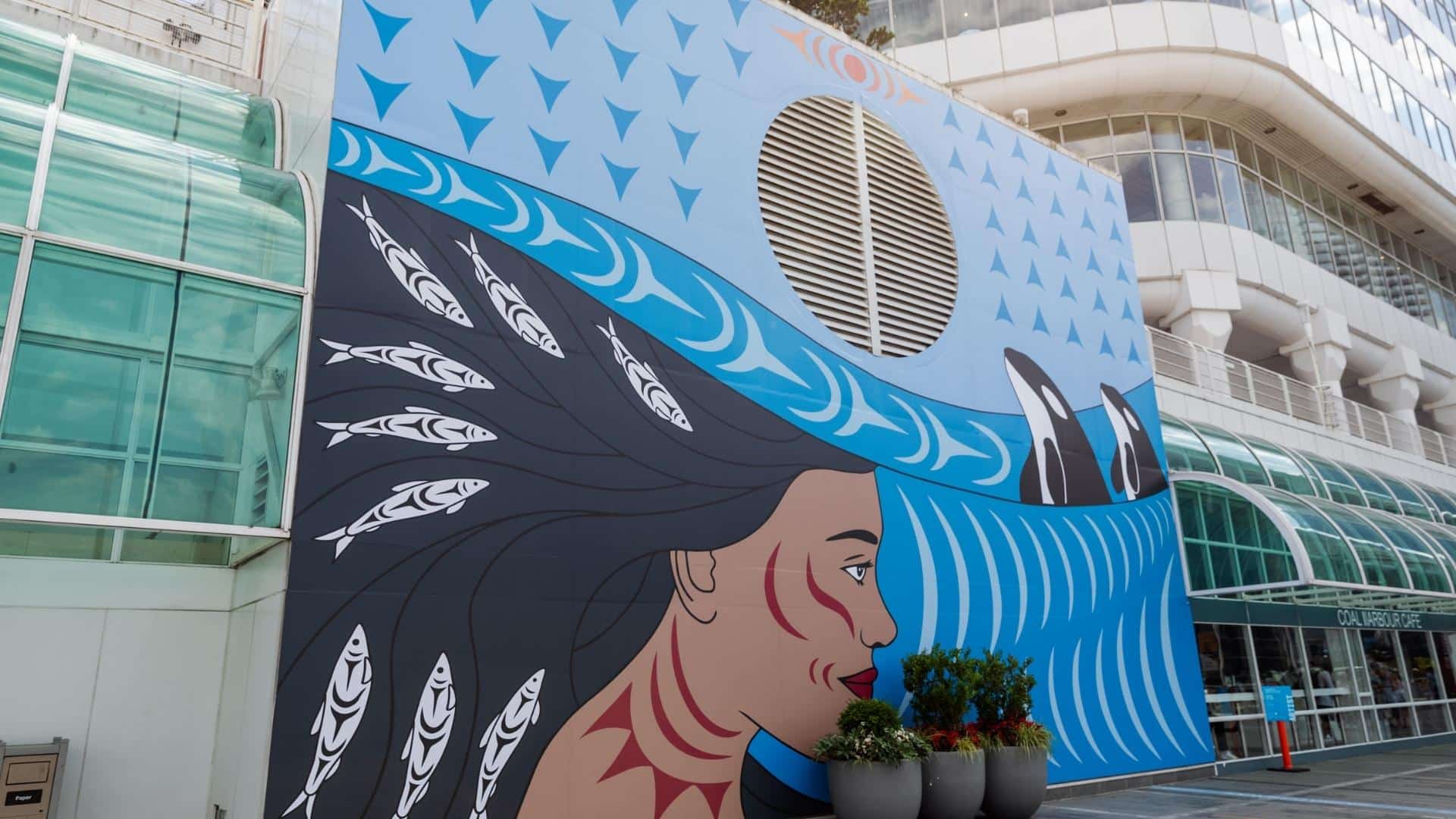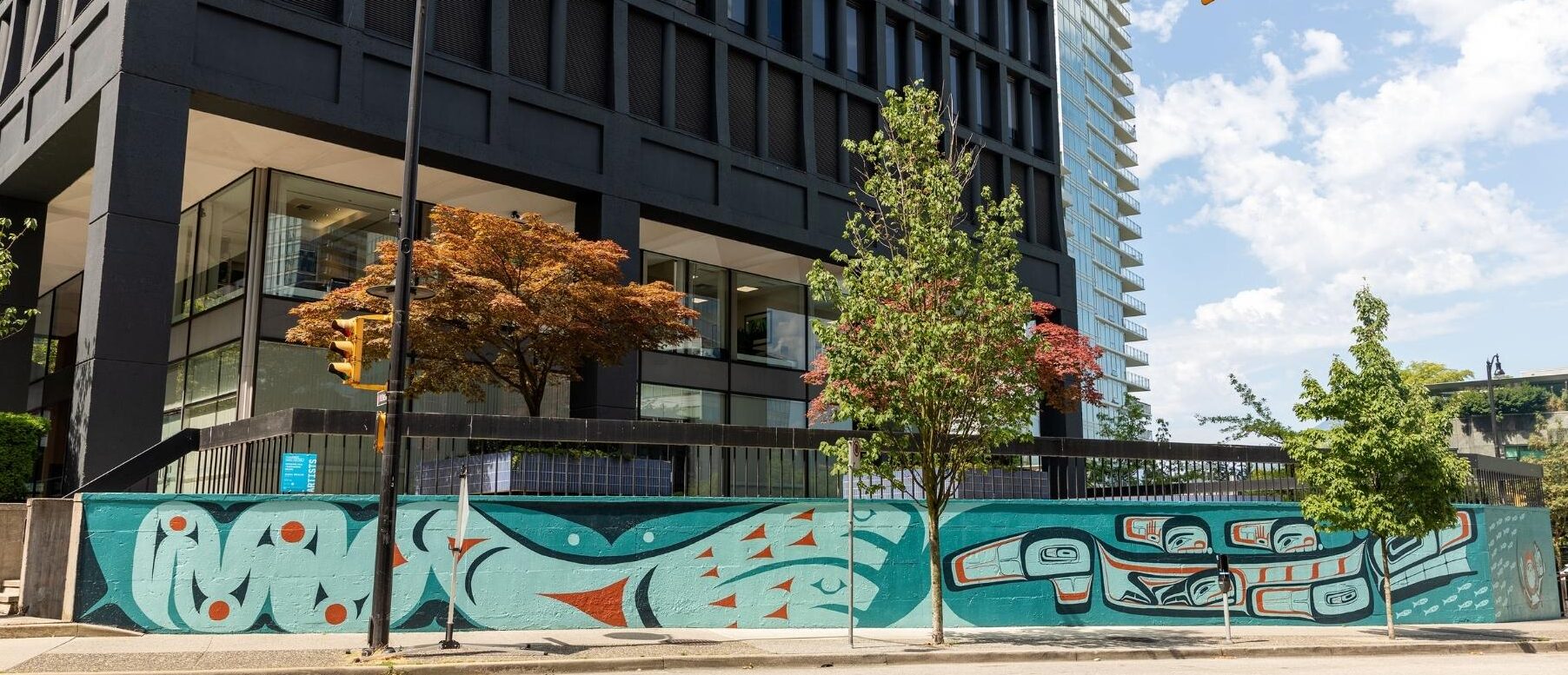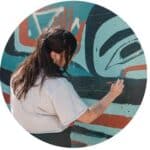
Painting the town blue for ocean conservation
Find out where you’ll find these ocean-inspired murals in Downtown Vancouver as part of Van Mural Fest 2022
Looking for fun things to do in Vancouver this summer? If you love the ocean – we’ve got two special treats for you this summer! Through lunchtime strolls and cycling commutes to our downtown office, the CPAWS-BC team started dreaming up ways to splash Nature art on the blank city walls about five years ago. This year, we’re thrilled to connect with Vancouver Mural Festival (VMF) and three Indigenous artists to create two massive ocean-inspired murals in Downtown Vancouver.
The artists have woven their culture and shared values to depict stories from the Salish Sea, along the Central Coast and up to Haida Gwaii and the North Coast. Both murals celebrate that while we may come from different places, it’s our shared responsibility to come together as one to protect our ocean and the coast for all life that depends on it. You can read more about the artists and the mural statements below.
The marine waters depicted in these murals have important conservation initiatives in progress. In the Salish Sea there is a proposed National Marine Conservation Area reserve for the Southern Strait of Georgia, learn more about the importance of this region by visiting Home of the Orcas. And in the waters around Haida Gwaii and along the BC coast from the Alaskan border to Northern Vancouver Island there is a process to create a network of marine protected areas. Learn more about the Great Bear Sea and how you can help support protecting these waters for future generations.
Thank you to the entire team at Vancouver Mural Festival for your support and guidance to bring these murals to life. These murals were made possible by generous support of the Doherty Family, BIA Vancouver, and IMPAC5.
The winds and the waters will always call us home
The winds and the waters will always call us home
By: Ocean Hyland/ shḵwen̓/ ts;simtelot
Printed vinyl located on lands and waters of the xʷməθkʷəy̓əm (Musqueam), Sḵwx̱wú7mesh (Squamish), Sel̓íl̓witulh (Tsleil-Waututh) Nations at 999 Canada Place in Downtown Vancouver, BC.
Herring lines the hair of the being connected to the sea. The visual representation of the changing tides is seen in front of her using Coast Salish elements, and an orca can be seen dancing in the current above.
Pacific herring are a staple food source for many inhabitants of the Salish Sea, including orcas and people. It is important to maintain a balance among the many species that live in the ocean. Our environment has looked after us, and although it remains generous, our relationship with it must be reciprocal. As much as we take, we must also give back.
Above the water line, droplets of the Salish Sea are absorbed by the sky so they can transform and make their way down as rain. Trigons represent the space where the water is called up to the sky and sent back down to water the plants, trees, and streams where the salmon are called to return. The moon sits high in the sky, and the Coast Salish eye mimics the sun and oversees the work done in our world. All life is connected: as the moon travels the sky, the tides flow, the wind blows, rain falls, the orcas are fed, and our people are happy. This reciprocal relationship ensures the well-being of us all.
About the Artist
Ocean Hyland/ shḵwen̓ / ts;simtelot
She/Her
Tsleil-Waututh
@dropletfromthesalishsea
salishshkwen.com
Ocean Hyland is an artist who works in the realms of painting and digital design. Along with her practices, she enjoys participating in language revitalization of Coast Salish languages. Ocean currently lives in Qualicum Bay on Vancouver Island.
As a young woman, Ocean received the ancestral name ts;simtelot, which was shared with her by her Mother. This name has been passed down through her family on her Cheam side. On her matrilineal side, she is Tsleil-Waututh, Squamish, Cheam, Hawaiian, and Chinese. Through her father, she is Scottish and Irish. The richness and diversity of her cultural heritage is what inspires Ocean in her many art practices.
Ocean has studied at both Native education college specializing in NWC jewelry arts, and at Simon Fraser University, focusing on the sḵwx̱ wú7mesh sníchim, building up her proficiency in one of her mother tongues. She has also gained valuable knowledge apprenticing with creators Zachary George and Aaron Nelson Moody.
Gud Gad iis & Nucama:t
Gud Gad iis & Nucama:t | Coming Together & Working as One
By: SGidGang.Xaal / Shoshannah Greene and Jessie Recalma/ Xwulqsheynum
Located on the lands and waters of the xʷməθkʷəy̓əm (Musqueam), Sḵwx̱wú7mesh (Squamish), and Sel̓íl̓witulh (Tsleil-Waututh) Nations at 1111 Hastings Avenue in Downtown Vancouver.
The Haida word, “Gud Gad iis” translates to “Coming Together”, with the meaning behind it being “Meeting people to discuss and talk”.
Inspired by the efforts to bring Indigenous leadership together for ocean conservation, this mural by SGidGang.Xaal / Shoshannah Greene and Jessie Recalma/ Xwulqsheynum reflects the collaborative approach to strengthen our combined efforts in working together to protect our home.
The design depicts a SGaana Saahlan Sdings, a Two-Fin killer whale. Inside the body are human figures, one in each dorsal fin and one in the belly. Together, they are traveling south from Haida Gwaii into Salish waters.
Welcoming them is their host, a two-headed sea serpent, sʔi:ɬqəy̓, who guides them through the mouth of the Fraser River.
A school of oolichon, an anadromous species of smelt, swims through the waters. A sea otter playfully holds the artist’s names like a sea urchin.
Learn more about how you can support a network of marine protections for the Great Bear Sea on the North and Central Coasts.
About the Artists
SGidGang.Xaal / Shoshannah Greene
She/Her
Haida
@thecatking
shoshannahgreene.tumblr.com
Shoshannah Greene was born and raised on Haida Gwaii, on the traditional Territory of her paternal ancestors. She was adopted into the Cumshewa Eagle Clan and given the Haida name SGid Gang.Xaal, meaning wild rose.
An appreciation of her culture and art came from an amalgamation of watching her father carve jewellery, attending local art classes, and being inspired daily by the natural surroundings.
Since childhood, Shoshannah loved to share stories and express her thoughts visually. Following graduation, she chose to pursue a Bachelor’s of Media Arts with a major in Animation at Emily Carr University of Art + Design. Today, her work focuses on combining hand-drawn animation with watercolour backgrounds, centering on the Super Naturals within Haida culture. Connecting the physical experience of the natural surroundings with Haida Supernaturals, thereby establishing a perspective on the juxtaposition of her natural world with Haida cosmologies. From what she sees around her, plants and animals, she draws a connection to what she feels and believes: everything has power and flowing energies. Having studied animation, she is using computer software to extend the ideas of supernaturals inhabiting the natural world with movement and character traits. This allows her to explore movement within natural cycles; her work concentrates on using light as a structural element in both animation and watercolor painting she is inviting viewers of her work to view natural elements as more than just representation, and to allow for the possibility of a deeper connection to their surroundings nourishing mind, body and spirit.
Jessie Recalma/ Xwulqsheynum
He/Him
Coast Salish – Qualicum First Nation
@saatlamarts |facebook.com/saatlamarts
salishshkwen.com
Jessie Recalma is a Coast Salish artist and a member of Qualicum First Nation. Jessie is a self-taught artist who learned watching and listening to the stories of his grandfather. One day Jessie had come across a carving knife in his grandfather’s desk and was given the knife to take home to try. This knife would be the first of many carving tools that are now used to create a unique blend of art that has a contemporary feel to it with a significant influence from the older generations. While carving is one of Jessie’s favourite mediums to work with, he also devotes his time to painting, Indigenous languages, and digital design. Jessie currently works privately out of his studio in his private studio in his house.
The name Saatlam Arts is rooted in one the name of an old village site “Saatlam” or “Place of Green Leaves”. Jessie felt it suitable to connect this old place name to his work as a nod to the ancestors of his home Territory.
Sign up to learn more about how you can help protect the Salish Sea, the Great Bear Sea and more.
Subscribe



